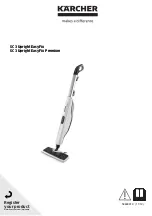
• To reduce the risk of falls, use extra
care when cleaning on stairs.
• To reduce the risk of personal injury or
damage to Vac, use only WORKSHOP
recommended accessories.
• When using as a detached blower:
- Direct air discharge only at work area.
- Turn unit off before setting on ground
or releasing grasp from handle.
- Do not set down in liquid; electric
shock could occur.
- Do not direct air at bystanders.
- Keep children away when blowing.
- Do not use blower for any job except
blowing dirt and debris.
- Do not use as a sprayer.
• To reduce the risk of eye injury, wear
safety eyewear. The operation of any
utility Vac or blower can result in
foreign objects being blown into the
eyes, which can result in severe eye
damage.
• Turn off Vac before unplugging.
• To reduce the risk of injury from
accidental starting, unplug power cord
before changing or cleaning Filter.
• Do not unplug by pulling on cord. To
unplug, grasp the plug, not the cord.
• Do not use with damaged cord, plug or
other parts. If your Vac is not working
as it should, has missing parts, has
been dropped, damaged, left outdoors,
or dropped into water, call customer
service.
• Do not pull or carry by cord, use cord
as handle, close a door on cord, or pull
cord around sharp edges or corners.
Do not run Vac over cord. Keep cord
away from heated surfaces.
• Do not handle plug, switch, or the Vac
with wet hands.
• Use only extension cords that are rated
for outdoor use. Extension cords in
poor condition or too small in wire size
can pose fire and shock hazards. To
reduce the risk of these hazards, be
sure the cord is in good condition and
that liquid does not contact the
connection. Do not use an extension
cord with conductors smaller than 16
gauge (AWG) in size. To reduce power
loss, use a 14 gauge extension cord if
25 to 50 ft long and 12 gauge for 50 ft
or longer.
• This Wet/Dry Vac is double-insulated,
eliminating the need for a separate
grounding system. Use only identical
replacement parts. Read the
instructions for Servicing Double-
Insulated Wet/Dry Vacs.
• Do not put any object into ventilation
openings. Do not vacuum with any
ventilation openings blocked; keep free
of dust, lint, hair or anything that may
reduce air flow.
• Keep hair, loose clothing, fingers, and
all parts of body away from openings
and moving parts.
CAUTION:
• To reduce the risk of hearing damage,
wear ear protectors when using for
extended time or in a noisy area.
• For dusty operations, wear dust mask.
• Static shocks are common when the
relative humidity of the air is low.
Vacuuming fine debris with your Vac
can deposit static charge on the hose
or Vac. To reduce the frequency of
static shocks in your home or when
using this Vac, add moisture to the air
with a humidifier.
!
3
SP6913-1 Workshop 4 Gallon.qxp_SP6439-3_ES.qxd 7/15/14 6:42 AM Page 3




































